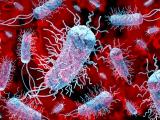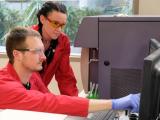Jan 10, 2013 (CIDRAP News) – A study involving a large group of patients hospitalized during Germany's 2011 outbreak of a rare type of Escherichia coli spread by contaminated sprouts found that some patients shed the pathogen for several weeks or months and that antibiotic use seemed to shorten the shedding time.
German researchers conducted the study at five university hospitals in northern Germany during the outbreak, one of the largest of its kind, which sickened 3,842 people and led to 53 deaths. The outbreak total included 855 patients who had hemolytic uremic syndrome (HUS), a potentially fatal kidney complication. The findings were published Jan 8 in an early online article from Clinical Infectious Diseases (CID).
Little is known about shedding of Shiga toxin-producing E coli (STEC) in adults, but the information is important because of the risk of secondary infections, the report says. Also, the authors noted that it's important to answer research questions about the shedding duration of the E coli O104:H4 strain, because it has not been found in food animals and might be adapted to humans, which could result in longer shedding times.
The researchers monitored E coli O104:H4 shedding patterns in 321 patients, including 104 males and 217 females. The median age was 40, with a range of 1 to 89. Investigators estimated that the median duration of shedding was 17 to 18 days, though some still tested positive at the end of the observation period of 157 days.
Patients who had HUS had shorter shedding durations, averaging 13 to 14 days, compared with those who didn't have the complication; the latter typically shed the pathogen for 33 to 34 days. The group found that children had longer shedding durations than adults and that patterns did not seem to vary by gender.
They pointed out that patients with HUS are likely to be overrepresented in the study, given that the severe infections were treated in university hospital settings.
Though antibiotic treatment is usually contraindicated for STEC infections because it can increase E coli toxin release and make the disease worse, some severely ill patients may still require the drugs, according to the authors. They found that a significant portion of the patients did receive antibiotic treatment and that this was associated with a significant decrease in the shedding period, but the report does not make clear exactly what the difference was.
The authors said their findings shouldn't be interpreted as a recommendation for antibiotic treatment of STEC patients and that carefully controlled trials are needed to address the issue.
The antibiotic findings seem to agree with the findings of a smaller German study of outbreak patients that appeared in a March 2012 issue of the Journal of the American Medical Association.
In a related commentary in CID, two experts from the US Centers for Disease Control and Prevention (CDC)—Rajal Mody, MD, MPH, and Patricia Griffin, MD—wrote that increasing use of assays to detect Shiga toxins or the genes that encode them have increased the detection of non-O157 STEC infections and improved outbreak investigations.
"With this surge in detection comes increasing questions from physicians, institutions, and health officials about reasonable and practical measures to prevent secondary infections," they wrote. Mody and Griffin are with the CDC's enteric diseases epidemiology branch.
Antibiotic therapy could be a useful adjunct to preventing secondary transmission, but lack of strong data supporting the benefits and observational studies showing increased risk currently argue against the strategy, they said. They noted that some research has hinted that antibiotic treatment at later stages of infection might carry less risk.
Mody and Griffin wrote that the German outbreak presented a unique opportunity to explore the antibiotic role, because doctors were using an experimental immunosuppressive drug, eculizamab, to treat patients, which required antibiotic prophylaxis to prevent meningitis. German infectious disease experts recommended azithromycin, because it was less likely to induce toxin release, they wrote.
The two emphasized the researchers' warning that the findings shouldn't be generalized to all STEC illnesses. Many questions remain before antibiotic eradication can be considered a safe strategy for preventing secondary infections, they wrote, adding, "The most important and effective means of preventing secondary cases will likely always remain early identification of primary cases with rapid implementation of hygienic and isolation precautions."
See also:
Jan 8 Clin Infect Dis abstract
Jan 8 Clin Infect Dis commentary
Mar 14, 2012, CIDRAP News scan "Antibiotic use in 2011 German outbreak may have cut shedding"

















